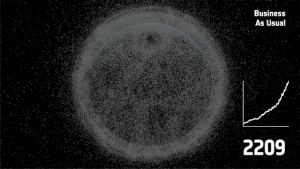
Space sustainability aims to maintain the safety and health of the space environment.[1]
Similar to sustainability initiatives on Earth, space sustainability seeks to use the environment of space to meet the current needs of society without compromising the needs of future generations.[2][3][4] It usually focuses on space closest to Earth, Low Earth Orbit (LEO), since this environment is the one most used and therefore most relevant to humans.[5] It also considers Geostationary Equatorial Orbit (GEO) as this orbit is another popular choice for Earth-orbiting mission designs.[6]
The issue of space sustainability is a new phenomenon that is gaining more attention in recent years as the launching of satellites and other space objects has increased.[7] These launches have resulted in more space debris orbiting Earth, hindering the ability of nations to operate in the space environment while increasing the risk of a future launch-related accident that could disrupt its proper use.[8][9] Space weather also acts as an outstanding factor for spacecraft failure.[6] The current protocol for spacecraft disposal at end-of-life has, at large, not been followed in mission designs and demands extraneous amounts of time for disposal.[10][11]
Precedent created through prior policy initiatives has facilitated initial mitigation of space pollution and created a foundation for space sustainability efforts.[10] To further mitigation, international and transdisciplinary consortia have stepped forward to analyze existing operations, develop standards, and incentivize future procedures to prioritize a sustainable approach.[12] A shift towards sustainable interactions with the space environment is growing in urgency due to the implications of climate change and increasing risk to spacecraft as time presses on.[11][13]
- ^ "Space Sustainability | Secure World". swfound.org. Retrieved 2021-03-17.
- ^ "Space Sustainability: A Practical Guide" (PDF). Secure World Foundation: 4. 2018.
- ^ "Long-term sustainability of outer space activities". www.unoosa.org. Retrieved 2021-03-17.
- ^ Johnson, Kaitlyn (2020). "Space Sustainability and Debris Mitigation". Center for Strategic and International Studies (CSIS): 15 – via JSTOR.
- ^ "ESA and UNOOSA illustrate space debris problem". www.esa.int. Retrieved 2021-03-17.
- ^ a b Cite error: The named reference
:0was invoked but never defined (see the help page). - ^ "We're launching more than ever". www.esa.int. Retrieved 2021-03-17.
- ^ Leman, Jennifer (2021-03-09). "Space Junk Poses a Serious Threat to 3,300 Functioning Satellites". Popular Mechanics. Retrieved 2021-03-17.
- ^ Undseth, Marit; Jolly, Claire; Olivari, Mattia (2020-04-08). "Space sustainability: The economics of space debris in perspective". OECD Science, Technology and Industry Policy Papers: 25–26. doi:10.1787/a339de43-en.
- ^ a b Cite error: The named reference
:4was invoked but never defined (see the help page). - ^ a b Cite error: The named reference
:3was invoked but never defined (see the help page). - ^ Cite error: The named reference
:7was invoked but never defined (see the help page). - ^ Cite error: The named reference
:12was invoked but never defined (see the help page).
© MMXXIII Rich X Search. We shall prevail. All rights reserved. Rich X Search
